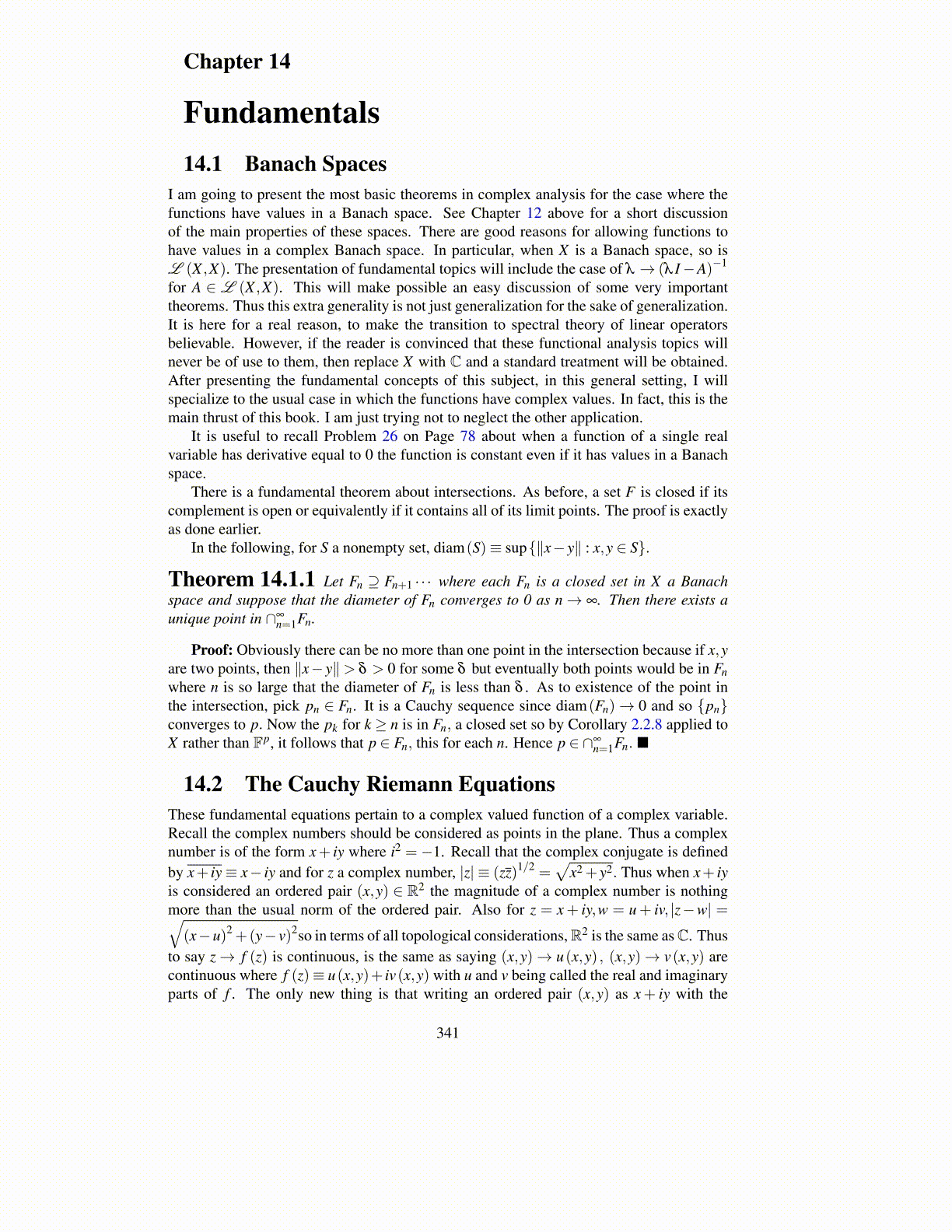
Chapter 14
Fundamentals14.1 Banach Spaces
I am going to present the most basic theorems in complex analysis for the case where thefunctions have values in a Banach space. See Chapter 12 above for a short discussionof the main properties of these spaces. There are good reasons for allowing functions tohave values in a complex Banach space. In particular, when X is a Banach space, so isL (X ,X). The presentation of fundamental topics will include the case of λ → (λ I−A)−1
for A ∈ L (X ,X). This will make possible an easy discussion of some very importanttheorems. Thus this extra generality is not just generalization for the sake of generalization.It is here for a real reason, to make the transition to spectral theory of linear operatorsbelievable. However, if the reader is convinced that these functional analysis topics willnever be of use to them, then replace X with C and a standard treatment will be obtained.After presenting the fundamental concepts of this subject, in this general setting, I willspecialize to the usual case in which the functions have complex values. In fact, this is themain thrust of this book. I am just trying not to neglect the other application.
It is useful to recall Problem 26 on Page 78 about when a function of a single realvariable has derivative equal to 0 the function is constant even if it has values in a Banachspace.
There is a fundamental theorem about intersections. As before, a set F is closed if itscomplement is open or equivalently if it contains all of its limit points. The proof is exactlyas done earlier.
In the following, for S a nonempty set, diam(S)≡ sup{∥x− y∥ : x,y ∈ S}.
Theorem 14.1.1 Let Fn ⊇ Fn+1 · · · where each Fn is a closed set in X a Banachspace and suppose that the diameter of Fn converges to 0 as n→ ∞. Then there exists aunique point in ∩∞
n=1Fn.
Proof: Obviously there can be no more than one point in the intersection because if x,yare two points, then ∥x− y∥> δ > 0 for some δ but eventually both points would be in Fnwhere n is so large that the diameter of Fn is less than δ . As to existence of the point inthe intersection, pick pn ∈ Fn. It is a Cauchy sequence since diam(Fn)→ 0 and so {pn}converges to p. Now the pk for k ≥ n is in Fn, a closed set so by Corollary 2.2.8 applied toX rather than Fp, it follows that p ∈ Fn, this for each n. Hence p ∈ ∩∞
n=1Fn. ■
14.2 The Cauchy Riemann EquationsThese fundamental equations pertain to a complex valued function of a complex variable.Recall the complex numbers should be considered as points in the plane. Thus a complexnumber is of the form x+ iy where i2 = −1. Recall that the complex conjugate is definedby x+ iy≡ x− iy and for z a complex number, |z| ≡ (zz)1/2 =
√x2 + y2. Thus when x+ iy
is considered an ordered pair (x,y) ∈ R2 the magnitude of a complex number is nothingmore than the usual norm of the ordered pair. Also for z = x+ iy,w = u+ iv, |z−w| =√(x−u)2 +(y− v)2so in terms of all topological considerations,R2 is the same asC. Thus
to say z→ f (z) is continuous, is the same as saying (x,y)→ u(x,y) , (x,y)→ v(x,y) arecontinuous where f (z)≡ u(x,y)+ iv(x,y) with u and v being called the real and imaginaryparts of f . The only new thing is that writing an ordered pair (x,y) as x + iy with the
341